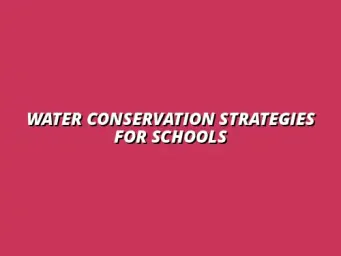Understanding the Importance of Water Conservation in Households
Water conservation is crucial for everyone, especially in our homes! With the rising concerns over water scarcity, it's essential to understand why every drop counts. By adopting simple yet effective water-saving practices, we can significantly contribute to the global effort of preserving this precious resource.
Every household plays a vital role in water conservation. It’s not just about saving money on bills; it’s about making a lasting impact on our environment and future generations. Let’s dive into the details of how our daily actions can lead to positive changes in water usage!
The Global Water Crisis and Its Impact on Households
The global water crisis is a reality that many of us may not fully appreciate. According to the United Nations, around 2 billion people live in countries experiencing water scarcity. This situation affects households, agriculture, and economies, ultimately leading to significant challenges in daily living.
As homeowners, we are directly connected to this issue. Water shortages not only impact the availability of water for personal use but can also influence local economies and community health. When we understand the implications, we can make informed decisions to help alleviate this pressing problem.
Statistics on Water Scarcity Worldwide
Here are some eye-opening statistics regarding water scarcity:
- Approximately 1 in 4 people worldwide will be affected by water scarcity by 2025.
- By 2040, it’s estimated that 1.8 billion people will live in areas of absolute water scarcity.
- More than 80% of wastewater is released into the environment without adequate treatment.
These figures highlight the urgency for action. When we see these numbers, it becomes clear that everybody's efforts matter tremendously!
Local Implications of Water Shortages
Locally, water shortages can lead to various issues that affect us all. For example:
- Increased water bills due to rising costs of water supply.
- Restrictions on water usage from local authorities.
- Negative impacts on local ecosystems and wildlife.
Understanding these implications helps emphasize the importance of conservation practices within our own homes. Every little step contributes to a broader solution!
The Role of Households in Water Conservation
Households can be powerful agents of change when it comes to water conservation. Every member of the family has a role to play, and even small adjustments in our daily routines can lead to significant savings. It’s all about raising awareness and taking actionable steps together!
By implementing water-saving techniques, we not only reduce our water footprint but also inspire others in our community to do the same. Let’s explore how individual actions can lead to larger solutions!
How Individual Actions Contribute to Larger Solutions
Here are some individual actions that households can take to contribute to water conservation:
- Fixing leaks promptly to prevent water waste.
- Collecting rainwater for garden use.
- Using a broom instead of a hose to clean driveways.
These small efforts can accumulate and make a big difference. By sharing these practices with friends and family, we can create a ripple effect that furthers our collective impact!
Benefits of Adopting Water-Saving Practices at Home
Adopting water-saving practices comes with multiple benefits, such as:
- Lower utility bills, which means more savings for your family.
- Increased lifespan of plumbing fixtures due to reduced wear and tear.
- A positive environmental impact that helps protect local water bodies.
At Plumb Pro Care, we believe that every household has the power to lead by example. Let’s make water conservation a family mission!
Common Questions About Water-Saving Practices
Water conservation can seem overwhelming at first, but it’s completely manageable, especially with the right information! Many people have common questions about how to save water effectively at home. In this section, I’m here to answer those queries and help you become more water-efficient.
From choosing the best devices to incorporating water-saving habits into daily routines, these tips will guide you toward making a positive change. Here’s what I’ve learned through my experience at Plumb Pro Care about water-saving practices!
What Are the Most Effective Water-Saving Devices for Home Use?
When it comes to saving water, having the right devices is key! Here’s a quick overview of some top water-efficient appliances that can make a significant difference in your household:
- Low-flow showerheads: These fixtures reduce water flow while maintaining pressure, helping you save gallons every shower!
- Dual-flush toilets: With options for liquid or solid waste, you can save water with every flush.
- Water-efficient washing machines: These machines use less water per load without compromising on cleaning quality.
- Smart irrigation systems: These systems adjust watering schedules based on weather conditions, ensuring your garden gets just the right amount of water.
Overview of the Best Water-Efficient Appliances
Investing in the right appliances is crucial for maximizing your water savings! Here’s a list of appliances you might want to consider:
- Water-saving dishwashers
- Low-flow faucets
- Greywater recycling systems
- Rainwater harvesting systems
By utilizing these devices, you can contribute to both lower water bills and a healthier planet!
Comparative Analysis of Cost vs. Water Savings
Now, let's talk numbers! While some water-efficient devices may have a higher upfront cost, they typically lead to substantial savings over time. To give you a clearer picture, here's a simple breakdown:
| Device | Average Cost | Estimated Annual Savings |
|---|---|---|
| Low-Flow Showerhead | $20 | $100 |
| Dual-Flush Toilet | $300 | $150 |
| Water-Efficient Washing Machine | $800 | $200 |
How Can Households Reduce Water Waste in Everyday Activities?
Even small changes in your daily routine can lead to significant water savings! Here are some simple tips to adjust your habits:
- Turn off the tap while brushing your teeth.
- Use a broom instead of a hose to clean driveways.
- Only run the dishwasher or washing machine with a full load.
- Shorten your shower by just a couple of minutes.
Each of these small adjustments can add up to huge water savings over time!
Involving Family Members in Water Conservation Efforts
Water conservation can be a family affair! Getting everyone involved not only makes it easier but also builds awareness among younger members. Here are a few ways to engage your family:
- Hold a family meeting to discuss water-saving goals.
- Assign roles for tasks like checking for leaks or collecting rainwater.
- Set up a fun challenge to see who can save the most water in a week!
Working together can turn water-saving practices into a fun family activity!
Long-Term Benefits and Community Involvement in Water Conservation
By saving water at home, you’re not just helping your wallet; you’re also contributing to the community! The long-term benefits of reduced water usage extend far beyond individual households. Let’s dive into these advantages!
The Financial Impact of Reduced Water Usage
Lowering your water consumption can have a positive impact on your finances, which is something we all appreciate! Here’s how you can start feeling those effects:
- Lower utility bills as a result of reduced water use.
- Increased home value due to water-efficient upgrades.
- Potential tax rebates for investing in water-saving technologies.
These financial benefits can help you save money for other important areas in your life!
How Water Conservation Can Lower Utility Bills
It’s amazing to think how much money we can save simply by using water wisely! For example, many families see a decrease in their monthly water bill by as much as 20%-50% after implementing water-saving devices and practices.
Tracking your water usage with monthly statements can help you see the difference. With Plumb Pro Care, we often encourage our clients to monitor their bills closely to witness their savings firsthand!
Investing in Water-Saving Technologies: Cost vs. Benefit
While investing in water-saving devices might feel like a significant cost initially, the long-term benefits are undeniable! Here’s a summary of the potential benefits:
- Reduced water bills over time.
- Lower energy costs from reduced hot water usage.
- Less strain on local water supply, contributing to community sustainability.
The investment can pay off in more ways than one!
Promoting Water-Saving Initiatives Within Your Community
Getting involved in community initiatives can amplify your impact on water conservation! Here are some steps you can take to promote better water usage:
- Join local environmental groups focused on water issues.
- Share your water-saving experiences on social media to inspire others.
- Organize community clean-up days around local water sources.
Working together strengthens our community and creates a positive ripple effect!
Partnering with Local Organizations to Advocate for Conservation
Building partnerships with local organizations can maximize your efforts! Collaborating with community groups can lead to:
- Workshops on water-efficient practices.
- Community challenges to reduce water usage collectively.
- Access to resources and grants for water-saving projects.
These partnerships can create a long-lasting impact on your community’s water conservation efforts!
Creating Awareness Campaigns to Educate Others
Education is key when it comes to water conservation! You can help by organizing awareness campaigns that focus on:
- Distributing flyers with water-saving tips.
- Hosting information sessions at local schools or community centers.
- Encouraging residents to share their water-saving stories.
Spreading the word can foster a culture of conservation and inspire others to take action!
Reflection on Personal Responsibility in Water Conservation
As we wrap up, it’s essential to reflect on our personal responsibility in conserving water. Each of us plays a vital role in ensuring our water resources are sustainable for future generations!
Identifying Your Water Footprint and Setting Goals
Understanding your water footprint is a fantastic first step! To assess your impact:
- Track your household water usage over a month.
- Identify areas where you can improve.
- Set specific, measurable goals for reducing water consumption.
This awareness can empower you to make positive changes!
Tools to Measure Personal Water Usage
There are many tools available that can help you measure your water usage! Consider using:
- Water meter readings to monitor usage.
- Smart home apps that track water consumption.
- Online calculators to estimate your water footprint.
These tools can provide valuable insights and guide your conservation efforts!
Setting Achievable Water Conservation Goals for the Household
When setting water conservation goals, make them realistic and achievable. Here’s how you can get started:
- Commit to reducing your water usage by 10% in the next month.
- Challenge your family to participate in a water-saving week.
- Implement one new water-saving device each quarter.
These goals can help you stay focused and motivated!
Encouraging Sustainable Practices for Future Generations
Teaching our children about water conservation is crucial for building a sustainable future! Here are some tips for instilling these values:
- Involve them in water-saving activities, such as gardening.
- Share stories about the importance of water conservation.
- Encourage them to track their water usage and set personal goals.
By fostering these practices, we can raise a generation that values water conservation.
Creating a Family Water Conservation Plan
Creating a family water conservation plan is a great way to ensure everyone is on board! Here’s how to develop one:
- Discuss water-saving goals as a family.
- Assign responsibilities for monitoring and managing water use.
- Review your progress regularly and adjust goals as needed.
With a shared plan, everyone can feel involved in making a difference!









